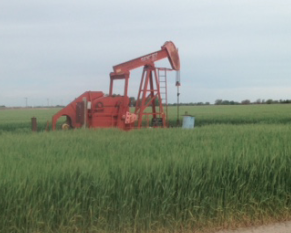By JOHN P. TRETBAR
It’s been a roller-coaster ride for Kansas crude prices over the last year. Kansas Common Crude at CHS in McPherson dropped $1.75 on Friday to close out the month of August at $45.25 per barrel. That’s a dollar more than the price at the beginning of the month, nearly ten dollars more than at the beginning of the year, but nearly eighteen dollars LESS than the price at the end of August of last year.
In its latest monthly crude-oil production report, the Energy Information Administration said U.S. operators produced 12.082 million barrels of crude oil in June, a slight drop from May’s total but more than 13% higher than the figure from June of last year. In Kansas production in June reached 92 million barrels, which is up two percent from the month before but down more than five percent from a year earlier.
Regulators report 94 new intent-to-drill notices across the state last month, down from 111 the month before and less than half the 236 intents reported in August of last year. The Kansas Corporation Commission reports seven new intents on file in Barton County, six in Ellis County and two in Stafford County. The year-to-date total is just 735 intents, compared to 1,303 intents through August of last year.
Independent Oil & Gas Service reports spotty muddy conditions continue to slow down drilling-rig movement across parts of the state. The weekly rig count is down one in eastern Kansas and up one west of Wichita. Operators were about to spud one well in Ellis County, and drilling was underway on one lease in Barton County.
Baker Hughes reported a big drop in its weekly rotary rig count Friday. Across the nation there 904 active rigs, marking a decline of 12 oil rigs. Canada reports 150 active rigs, up eleven from the week before. The count in Texas down down five rigs. Oklahoma was down two, while North Dakota gained three rigs.
There are 24 new drilling permits across Kansas this week, six in eastern Kansas and 18 west of Wichita, including three in Barton County and one in Ellis County. The total so far this year of 649 new drilling permits.
Independent Oil & Gas Service reported 14 newly completed wells in Kansas last week including one in Barton County.. That’s 964 completions so far this year. There were three new completions east of Wichita and eleven in Western Kansas.
Quintana Energy Services announced last week it’s selling conventional operations in Kansas and Oklahoma to a Wichita firm, but will retain its extensive interests in horizontal wells and hydraulic fracturing in several of the nation’s biggest shale plays. Wichita-based oilfield service company Hurricane Services is paying $4.4 million for conventional operations located in Bartlesville, Oklahoma as well as Oakley, Ottawa, Thayer and El Dorado in Kansas.
The Nebraska Supreme Court gave its blessing to the latest route planned for the Keystone Pipeline expansion. The ruling paves the way for construction to begin, although opponents say the fight to stop the project is “far from over.” The pipeline faces other hurdles, including a federal lawsuit in Montana and ongoing opposition from Native American tribes in Nebraska and South Dakota.
Construction could begin soon on the TransMountain pipeline expansion, which would more than double the amount of heavy crude moved from Alberta to Canada’s Pacific coast. Work has restarted at the storage terminal where the pipeline terminates, and at a marine terminal where crude is loaded onto tankers.
Canada’s government has shuffled its energy regulators in a new law which went into effect last week The National Energy Board officially becomes the Canada Energy Regulator. The agency’s Web site promises improvements in decision-making, greater participation by the public and tribal interests, and improved safety and environmental protection.
Despite a decline in railroad freight traffic generally, oil-by-rail continues to show gains over last year at this time. The Association of American Railroads reports 12,212 tanker cars hauling petroleum and petroleum products during the week ending August 24. That’s up 7.8% compared to the same week last year. The year-to-date total is up more than 20% over last year. Total freight traffic by rail was down 6.5% last week.
Weekly reporting from the government shows record-high crude-oil production and a big drop in imports. U.S. crude production set an all-time record. The Energy Information Administration reports operators pumped 12.5 million barrels per day during the week ending August 23. That tops last week’s report by 161,000 barrels per day, and beats the previous all-time record (set May 31) by 122,000 barrels per day. The government also reported a dramatic drop in U.S. crude-oil imports, down about 1.3 million barrels to 5.9 million barrels per day. The four-week average is down more than 12 percent from the same four-week period last year.
Crude oil inventories are down ten million barrels in the latest weekly tally. EIA said total domestic stockpiles match the five-year seasonal average, at 427.8 million barrels.

